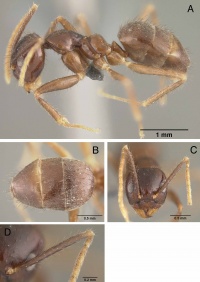Euprenolepis thrix
| Euprenolepis thrix | |
|---|---|

| |
| Scientific classification | |
| Kingdom: | Animalia |
| Phylum: | Arthropoda |
| Class: | Insecta |
| Order: | Hymenoptera |
| Family: | Formicidae |
| Subfamily: | Formicinae |
| Tribe: | Lasiini |
| Genus: | Euprenolepis |
| Species: | E. thrix |
| Binomial name | |
| Euprenolepis thrix LaPolla, 2009 | |
Nothing is known about the biology of this species.
Identification
This species is easily distinguished from other Euprenolepis species by the dense layer of pubescence on the gaster. Only two other species also have pubescence on the gaster: Euprenolepis procera and Euprenolepis zeta. Euprenolepis thrix is easily distinguishable from E. procera by the smooth surface of the cephalic and mesosomal cuticle. Euprenolepis thrix is distinguishable from E. zeta by denser gastral pubescence. Also, E. thrix and E. zeta have the head slightly broader than long (CI typically greater than 100), whereas other Euprenolepis have the head slightly longer than broad (CI typically less than 100). Shared body coloration, head shape, and the presence of pubescence on the gaster probably indicate that E. thrix and E. zeta are close relatives. (Lapolla 2009)
Keys including this Species
Distribution
Latitudinal Distribution Pattern
Latitudinal Range: 6.150000095° to 6.033333°.
| North Temperate |
North Subtropical |
Tropical | South Subtropical |
South Temperate |
- Source: AntMaps
Distribution based on Regional Taxon Lists
Indo-Australian Region: Borneo, Indonesia, Malaysia (type locality).
Distribution based on AntMaps
Distribution based on AntWeb specimens
Check data from AntWeb
Countries Occupied
| Number of countries occupied by this species based on AntWiki Regional Taxon Lists. In general, fewer countries occupied indicates a narrower range, while more countries indicates a more widespread species. |

|
Estimated Abundance
| Relative abundance based on number of AntMaps records per species (this species within the purple bar). Fewer records (to the left) indicates a less abundant/encountered species while more records (to the right) indicates more abundant/encountered species. |

|
Biology
|
Castes
Nomenclature
The following information is derived from Barry Bolton's Online Catalogue of the Ants of the World.
- thrix. Euprenolepis thrix LaPolla, 2009: 17, figs. 10A-D (w.) BORNEO.
Type Material
- Paratype, 1 worker, Poring Hot Spring, East Ridge, Kinabalu National Park, Sabah, Malaysia, Bruhl,C., ANIC32-051662, Australian National Insect Collection.
Unless otherwise noted the text for the remainder of this section is reported from the publication that includes the original description.
Description
Worker
Measurements (n=3): TL: 3.35–4.18; HW: 0.97–1.11; HL: 0.91–1.04; SL: 1.18–1.23; WL: 1.3–1.42; GL: 1.14–1.72. Indices: CI: 104–107; SI: 110–122.
Head brown, with lighter yellowish-brown mandibles and funiculi; head about as long as broad. Cuticular surface shiny and smooth, with scattered erect setae and sparse pubescence that is thickest in area under the eyes. Posterior margin complete. Scapes surpass posterior margin by about length of the first four funicular segments. Scapes with erect setae and a layer of pubescence, becoming denser distally. Mesosoma brown, smooth, and shiny, legs becoming lighter distally, especially tarsi, which are yellowish-brown. Mesosomal dorsum with scattered erect setae of varying lengths; cuticular surface without pubescence; legs with short erect setae. Pronotum rises at about 45° toward mesonotum; propodeum dorsum rounded, dome-like; declivity steep. Petiole triangular with posterior face longer than anterior face; gaster brown, with scattered erect setae and a dense layer of pubescence; cuticular surface shiny, and weakly regureticulate.
Type Material
Holotype worker, MALAYSIA: Borneo, Kinabalu Nat. Park, Poring Hot Spring, East Ridge, 800 m, 1995 (C. Brühl) (National Museum of Natural History); 3 paratype workers, same locality as holotype (Australian National Insect Collection; USNM).
Etymology
The species epithet is Greek for hair, in reference to the pubescence that covers the gaster of this species.
References
- LaPolla, J. S. 2009. Taxonomic revision of the Southeast Asian ant genus Euprenolepis. Zootaxa. 2046:1-25.
- Yamane, S., Tanaka, H.O., Hasimoto, Y., Ohashi, M., Meleng, P., Itioka, T. 2021. A list of ants from Lambir Hills National Park and its vicinity, with their biological information: Part II. Subfamilies Leptanillinae, Proceratiinae, Amblyoponinae, Ponerinae, Dorylinae, Dolichoderinae, Ectatomminae and Formicinae. Contributions from the Biological Laboratory, Kyoto University 31, 87–157.
References based on Global Ant Biodiversity Informatics
- CSIRO Collection
- LaPolla J. S. 2009. Taxonomic revision of the Southeast Asian ant genus Euprenolepis. Zootaxa 2046: 1-25.
- Lapolla, J. S.. "Taxonomic Revision of the Southeast Asian Ant Genus Euprenolepis." Zootaxa 2046 (2009): 1-25.
- Pfeiffer M.; Mezger, D.; Hosoishi, S.; Bakhtiar, E. Y.; Kohout, R. J. 2011. The Formicidae of Borneo (Insecta: Hymenoptera): a preliminary species list. Asian Myrmecology 4:9-58